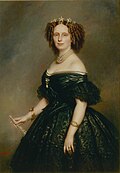| No. | Picture | Name | Coat of Arms | Father | Mother | Birth | Marriage | Became Consort | Ceased to be Consort | Death | Spouse |
|---|
| 1 |  | Friederike Luise Wilhelmine of Prussia | | Frederick William II of Prussia
(Hohenzollern) | Frederica Louisa of Hesse-Darmstadt
(Hesse-Darmstadt) | 18 November 1774 | 1 October 1791 | 16 March 1815
husband's ascension | 12 October 1837 | William I |
|---|
| 2 |  | Anna Pavlovna of Russia |  | Paul I of Russia
(Holstein-Gottorp-Romanov) | Maria Feodorovna
(Württemberg) | 18 January 1795 | 21 February 1816 | 7 October 1840
husband's ascension | 17 March 1849
husband's death | 1 March 1865 | William II |
|---|
| 3 |  | Sophie Friederike Matilda of Württemberg |  | William I of Württemberg
(Württemberg) | Catherine Pavlovna of Russia
(Holstein-Gottorp-Romanov) | 17 June 1818 | 18 June 1839 | 17 March 1849
husband's ascension | 3 June 1877 | William III |
|---|
| 4 |  | Adelheid Emma Wilhelmina Theresia of Waldeck and Pyrmont |  | George Victor, Prince of Waldeck and Pyrmont
(Waldeck) | Princess Helena of Nassau
(Nassau-Weilburg) | 2 August 1858 | 7 January 1879 | 23 November 1890
husband's death | 20 March 1934 |
|---|
| 5 |  | Heinrich (Henry) Wladimir Albrecht Ernst of Mecklenburg-Schwerin |  | Frederick Francis II, Grand Duke of Mecklenburg-Schwerin
(Mecklenburg) | Princess Marie of Schwarzburg-Rudolstadt
(Schwarzburg-Rudolstadt) | 19 April 1876 | 7 February 1901 | 3 July 1934 | Wilhelmina |
|---|
| 6 |  | Bernhard Leopold Friedrich Eberhard Julius Kurt Karl Gottfried Peter of Lippe-Biesterfeld |  | Prince Bernhard of Lippe-Biesterfeld
(Lippe) | Armgard von Cramm
(Cramm) | 29 June 1911 | 8 September 1936 | 6 September 1948
wife's ascension | 30 April 1980
wife's abdication | 1 December 2004 | Juliana |
|---|
| 7 |  | Klaus-Georg (Claus) Wilhelm Otto Friedrich Gerd von Amsberg |  | Claus Felix von Amsberg
(Amsberg) | Baroness Gösta von dem Bussche-Haddenhausen
(Bussche-Haddenhausen) | 6 September 1926 | 10 March 1966 | 30 April 1980
wife's ascension | 6 October 2002 | Beatrix |
|---|
| 8 |  | Máxima Zorreguieta Cerruti |  | Jorge Zorreguieta | María del Carmen Cerruti Carricart | 17 May 1971 | 2 February 2002 | 30 April 2013
husband's ascension | Incumbent | Willem-Alexander |
|---|
|
















